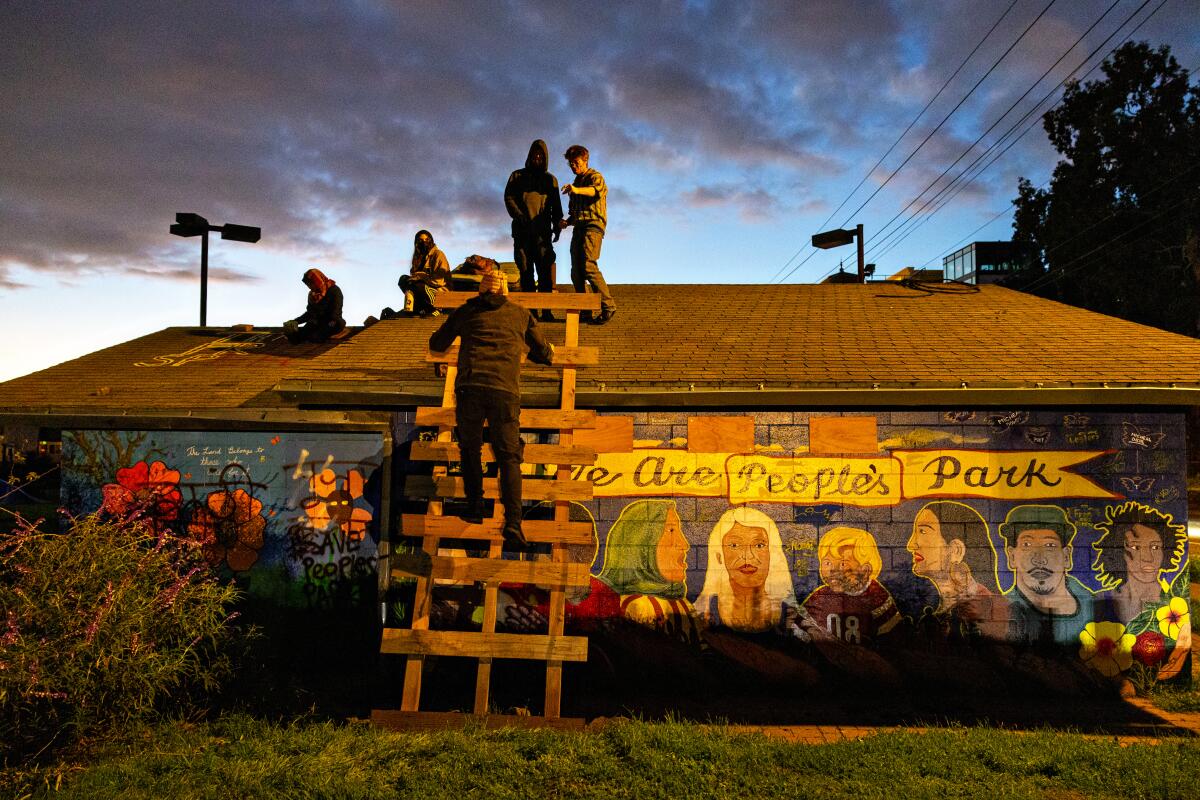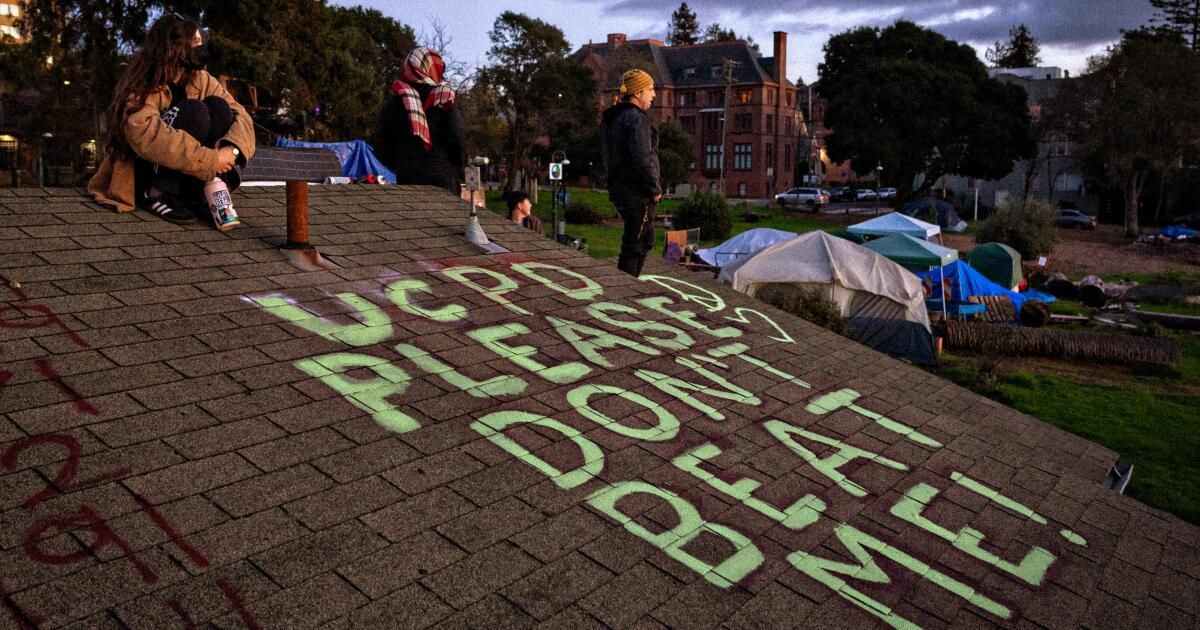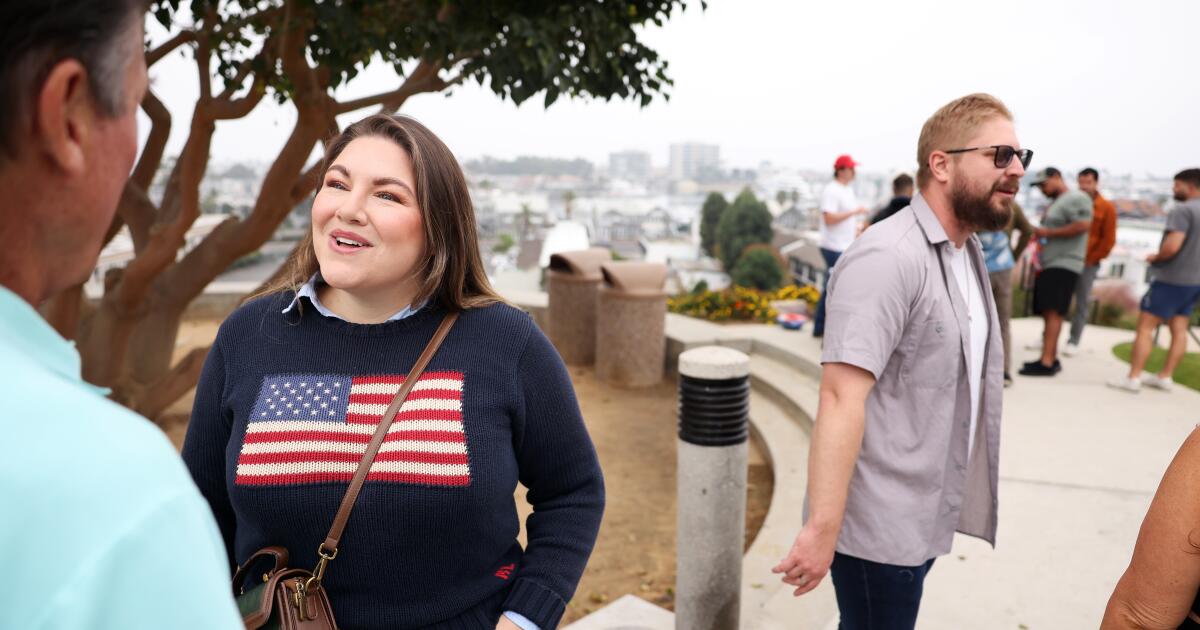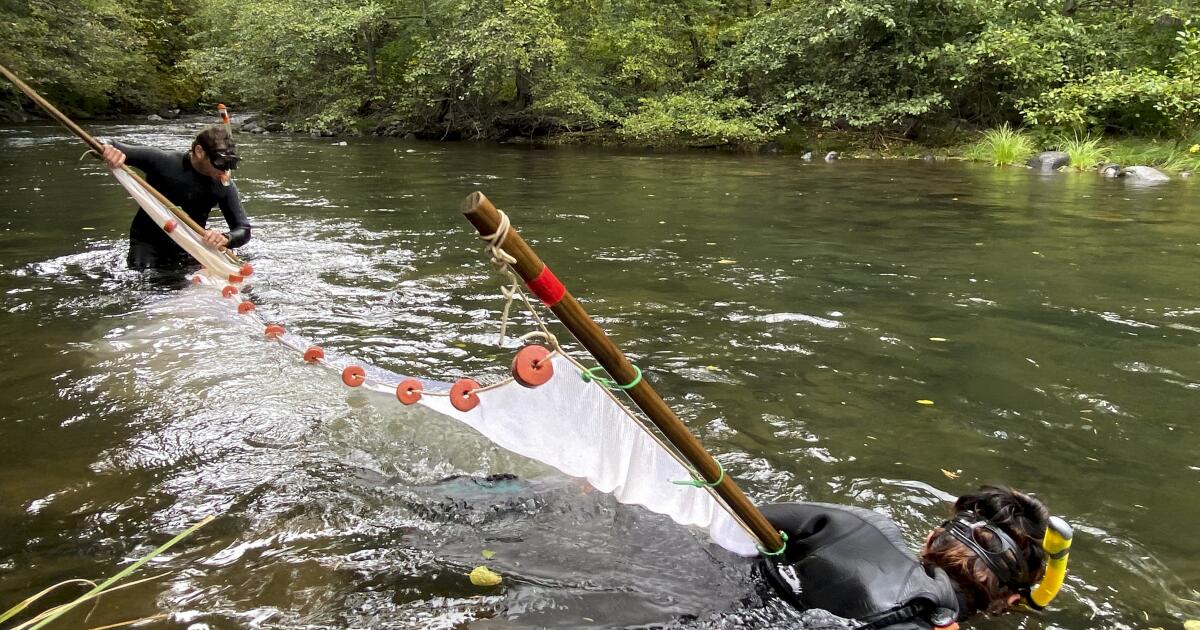A massive contingent of law enforcement officers gathered at People’s Park in the early hours of Thursday morning, intent on clearing the way for crews to board up the historic green space near the UC Berkeley campus in preparation for construction of a hotly contested housing complex for students.
The university launched the extraordinary operation, designed to stack two metal cargo containers around the entire perimeter of the park, around 12 a.m.
Upon arrival, police surrounded the park. Inside, they were greeted by several dozen protesters, chanting “Long live People’s Park” along with shouts of “Counterattack!” Some were hiding in a makeshift treehouse and on the roof of a single-story building in the park.
By beginning the exercise under the cover of darkness and during the students’ winter break, university leaders hoped to minimize a conflict with activists who insisted that the park should remain an open space, a living tribute to free speech. and student activism. The university planned to set up the shipping containers over several days, confident that the massive metal structures would provide a more formidable barrier than the fences that protesters had easily breached in the past.
The university acknowledged that construction of the housing, caught in a legal dispute, cannot begin unless the state Supreme Court agrees that the Berkeley campus has completed an adequate environmental review of the project. The proposed development would create a dormitory with space for 1,100 students in a college town with a severe shortage of affordable housing. Additionally, it would include permanent supportive housing for 125 people experiencing homelessness. About 60% of the site would remain green space, with commemorative exhibits about the park’s history.
“Given that existing legal issues will inevitably be resolved, we decided to take this necessary step now to minimize the potential for disorder and disruption to the public and our students when we are eventually cleared to resume construction,” Chancellor Carol Christ said. in a prepared statement.
The university said it intended to keep streets closed around the park, and at least a block to the north and east, for three or four days.
“Unfortunately, our planning and actions must take into account that some of the project’s opponents have previously resorted to violence and vandalism,” Christ said, adding that this was “despite strong support for the project from students, community members, homeless advocates, the elected leaders of the city of Berkeley, as well as the California state legislature and governor.”
Activists determined to preserve the park were warned several days in advance that the university would attempt to cordon off the site while students were on vacation. They called the incursion by law enforcement and task forces an “attack” that would destroy a legacy of people-powered activism.
Nicholas Alexander was among activists guarding People’s Park on Wednesday night, prepared to protest against attempts to fence the site.
(Jason Armond / Los Angeles Times)
Nicholas Alexander was among a small group guarding the park Wednesday afternoon at dusk. Alexander, who was once homeless, praised the park as a place where people in need have been able to turn for decades for help. He said he was part of the group that helped tear down a fence built by the university in 2022. “This park has always helped the counterculture and the marginalized,” he said, “and it would be a shame if it was taken away from us.” Now, because where else will we go?”
Another member of the group monitoring the park, Sylvia Tree, said she had graduated from Berkeley in 2021. She described the conflict as “a land-based struggle.”
“It’s a place where people who don’t own any land can have a little piece of it, a piece where they can grow things, where they can have sunlight, where they can meet their friends,” he said. Tree. 25. “There is no one to control it. There is no one to sell you anything.”
This passionate advocacy has become a perennial ritual in the small green area just south of campus and a few steps east of Telegraph Avenue.
It began more than half a century ago, in 1969, when the founding campus of the UC system announced its development plan on what was then vacant land. Hundreds of students and community activists had another idea: They dragged grass, trees and flowers onto the land and proclaimed it People’s Park. The university responded by erecting a fence.
The Daily Californian student newspaper urged students to “take back the park.” More than 6,000 people marched down Telegraph, where they were confronted by law enforcement. In the ensuing clash, one man was killed and dozens injured.
In the decades since, the university has made repeated efforts to reclaim the property, once attempting to build a parking lot on the edge of the park. A new generation of protesters arrived, with shovels and pickaxes, to tear up the asphalt and restore plant life.
In the early 1990s, a young, machete-wielding activist enraged by the university’s construction of volleyball courts in the park was shot and killed by police after she broke into the campus residence hall. of the then rector Chang-Lin Tien. Police said they found a note in the teen’s purse. She said: “We are willing to die for this piece of land. Are you?”
The push for the university to develop the property gained new life after Cristo became chancellor in 2017 amid a student housing crisis. Since Berkeley provides housing to a smaller percentage of its students than any other UC campus, Christ promised to double the number of beds within a decade. He made it clear that he considered People’s Park — long a “third rail” that university leaders avoided — to be a good location for housing.

Tensions over UC Berkeley’s efforts to develop People’s Park have generated more than half a century of activism and debate.
(Jason Armond / Los Angeles Times)
Opponents of housing development argue that UC Berkeley has not done enough to study alternative sites. Their cause got a boost in December, when a unit of the National Trust for Historic Preservation wrote a letter asking to “explore all possible opportunities” for preserving the park.
The university responds that its plan recognizes the historic nature of the park while attempting to address problems that have plagued the site and nearby streets in recent years, including homeless encampments, open drug use, petty theft and violence. . UC Police Chief Yogananda Pittman characterized this week’s action as necessary to provide community members “the security they need and deserve.”
The university published the results of a survey in 2021 that showed that students support the project between 56% and 31%. More recently, in an effort to address complaints that the proposed development would displace homeless people living in the park, the university hired a full-time social worker and said most of the park’s inhabitants had been relocated at a Quality Inn and offered support services.
But the project suffered a setback early last year when a state appeals court ruled that UC had not adequately complied with the California Environmental Quality Act, a decades-old law. known as CEQA, which Requires state and local governments to consider the environmental impacts of certain construction and housing projects. The court concluded that the university had not adequately addressed the issue of noise, specifically noise generated by students who might be drinking and holding “unruly parties,” as some neighbors claimed in court documents.
The court also ruled that the campus had not adequately justified its decision not to consider alternative locations for housing development. UC attorneys have said that because the goal of the project is to reuse the park, no alternative would be sufficient.
The university appealed the decision to the state Supreme Court and also appealed to the Legislature. Lawmakers passed a law, signed by Gov. Gavin Newsom in September, designed to make it easier for universities to build housing and overcome lawsuits from residents who raise concerns about noise as a potential problem.
All parties in the dispute await a decision from the high court, and the new law will presumably be a factor in their deliberations.
UC’s last concerted effort to take over the park for construction came in August 2022. Just hours after an Alameda County judge issued a tentative ruling that the university could begin cleaning up the park, construction machinery was installed in its place. But the 2 a.m. operation soon drew protesters who clashed with construction crews, tore down a newly constructed metal fence and streamed into the park, where they were confronted by California Highway Patrol officers.
At the end of the day, the university ended the standoff by suspending its effort to take control of the park.
Berkeley City Councilwoman Kate Harrison issued a public letter this week asking police involved in any new confrontations with protesters to “follow the city of Berkeley’s rules regarding the use of ‘less lethal’ weapons and tactics.” “, which include the prohibition of the use of pepper spray and tear gas. Harrison added: “These rules, established to protect human life and people’s First Amendment rights, are fundamental to the value of our City.”
Photographer Jason Armond contributed to this report.












